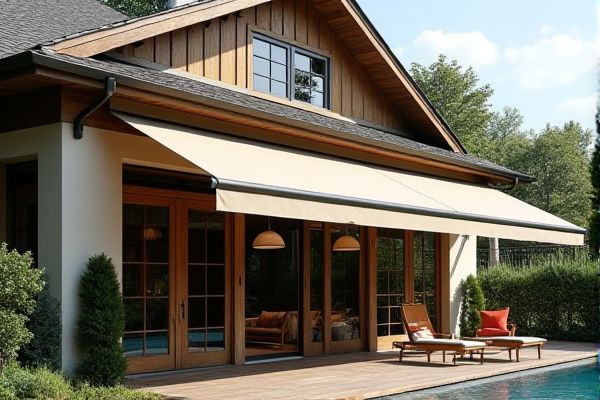
Metal awnings offer superior durability and weather resistance, making them ideal for long-term protection against harsh elements, while fabric awnings provide versatile design options and easy installation with a lighter, more flexible appearance. Discover which option best suits your needs by exploring the detailed comparison in this article.
Table of Comparison
| Feature | Metal Awning | Fabric Awning |
|---|---|---|
| Material | Aluminum, steel, or copper | Canvas, acrylic, or polyester |
| Durability | Highly durable, lasts 10-20+ years | Moderate durability, lasts 5-10 years |
| Maintenance | Low maintenance; occasional cleaning | Requires periodic cleaning and fabric replacement |
| Weather Resistance | Excellent resistance to wind, rain, and sun | Good sun protection; less wind and rain resistant |
| Appearance | Modern, sleek, and permanent look | Soft, versatile design; available in multiple colors |
| Installation | More complex, professional installation needed | Generally easier and quicker to install |
| Cost | Higher upfront cost | Lower initial cost |
| Customization | Limited shape and color options | Wide variety of shapes, colors, and patterns |
| Energy Efficiency | Good at reflecting heat, reducing cooling costs | Provides shade; fabric color affects heat absorption |
Introduction to Metal and Fabric Awnings
Metal awnings provide durable, weather-resistant protection with materials such as aluminum and steel, offering long lifespan and minimal maintenance requirements. Fabric awnings use materials like acrylic or polyester, delivering flexible designs, vibrant colors, and UV protection but typically require more upkeep. Both types enhance outdoor spaces, yet metal awnings excel in durability while fabric options prioritize aesthetics and versatility.
Key Differences Between Metal and Fabric Awnings
Metal awnings offer superior durability and require minimal maintenance, making them ideal for long-term use in harsh weather conditions, while fabric awnings provide greater design flexibility with various colors and patterns, enhancing aesthetic appeal. Metal awnings typically have a longer lifespan, often exceeding 20 years, whereas fabric awnings may last between 5 to 15 years depending on material quality and exposure. Energy efficiency is another critical factor, as metal awnings effectively reflect sunlight, reducing cooling costs, while fabric awnings offer better ventilation but may require regular cleaning and replacement.
Durability and Lifespan Comparison
Metal awnings offer superior durability and a longer lifespan, typically lasting 20 to 30 years due to their resistance to weather elements, rust, and fading. Fabric awnings generally last about 5 to 10 years and require more maintenance since they are prone to tearing, mildew, and UV damage. Choosing a metal awning can ensure your outdoor space remains protected and low-maintenance over time.
Aesthetic and Design Options
Metal awnings offer sleek, modern aesthetics with a variety of finishes such as brushed aluminum, galvanized steel, or painted coatings that enhance durability and visual appeal. Fabric awnings provide versatile design options with numerous colors, patterns, and textures, allowing you to customize the look to match your exterior decor and create a softer, more inviting atmosphere. Your choice depends on whether you prefer the contemporary, durable appearance of metal or the vibrant, customizable style of fabric.
Weather Resistance and Protection
Metal awnings provide superior weather resistance, offering durable protection against heavy rain, strong winds, and intense UV rays due to their rigid and rust-resistant materials like aluminum or steel. Fabric awnings, while available in water-repellent and UV-resistant options, generally offer less durability under extreme weather conditions and may require more frequent maintenance or replacement. Metal awnings also resist fading and tearing better than fabric, ensuring long-term shielding for windows and outdoor spaces.
Maintenance Requirements for Each Awning Type
Metal awnings require minimal maintenance, needing occasional cleaning and inspection for rust or corrosion, especially in coastal or humid environments. Fabric awnings demand more frequent upkeep, including cleaning to prevent mold, mildew, and fabric deterioration, as well as regular resealing or waterproofing treatments. Choosing between metal and fabric awnings depends on balancing the durability and low-maintenance nature of metal with the aesthetic versatility and renewal needs of fabric options.
Energy Efficiency and Shade Performance
Metal awnings offer superior energy efficiency by reflecting sunlight and reducing heat absorption, which helps maintain cooler indoor temperatures and lowers air conditioning costs. Fabric awnings provide excellent shade performance with their ability to block UV rays and create a comfortable outdoor space while allowing some airflow for ventilation. Choosing the right awning depends on your priorities for heat reduction and shade quality in your specific environment.
Cost Considerations: Installation and Long-Term Value
Metal awnings generally have higher upfront installation costs due to durable materials and specialized labor, but they offer superior long-term value with low maintenance and extended lifespan, often exceeding 20 years. Fabric awnings are more affordable initially and easier to install, yet they require more frequent replacement and repairs, typically lasting 5 to 10 years depending on weather exposure. Evaluating total cost of ownership reveals metal awnings as cost-effective over time, while fabric awnings suit budget-conscious projects with shorter usage expectations.
Best Applications for Metal vs Fabric Awnings
Metal awnings excel in durability and low maintenance, making them ideal for commercial buildings, harsh weather environments, and long-term sun protection. Fabric awnings offer versatility and aesthetic appeal, suitable for residential patios, windows, and areas requiring customizable designs and color options. Consider your outdoor space's exposure and style needs to choose the best option for your awning solution.
Choosing the Right Awning for Your Needs
Metal awnings provide durable, weather-resistant protection ideal for long-term use in harsh climates, while fabric awnings offer versatile design options and easier customization to match aesthetic preferences. Consider factors such as climate exposure, maintenance requirements, and budget when selecting between aluminum or steel metal awnings and acrylic or polyester fabric awnings. Prioritize durability for areas with heavy rain or snow, or choose fabric for flexibility in design and seasonal adjustments.
 homyna.com
homyna.com